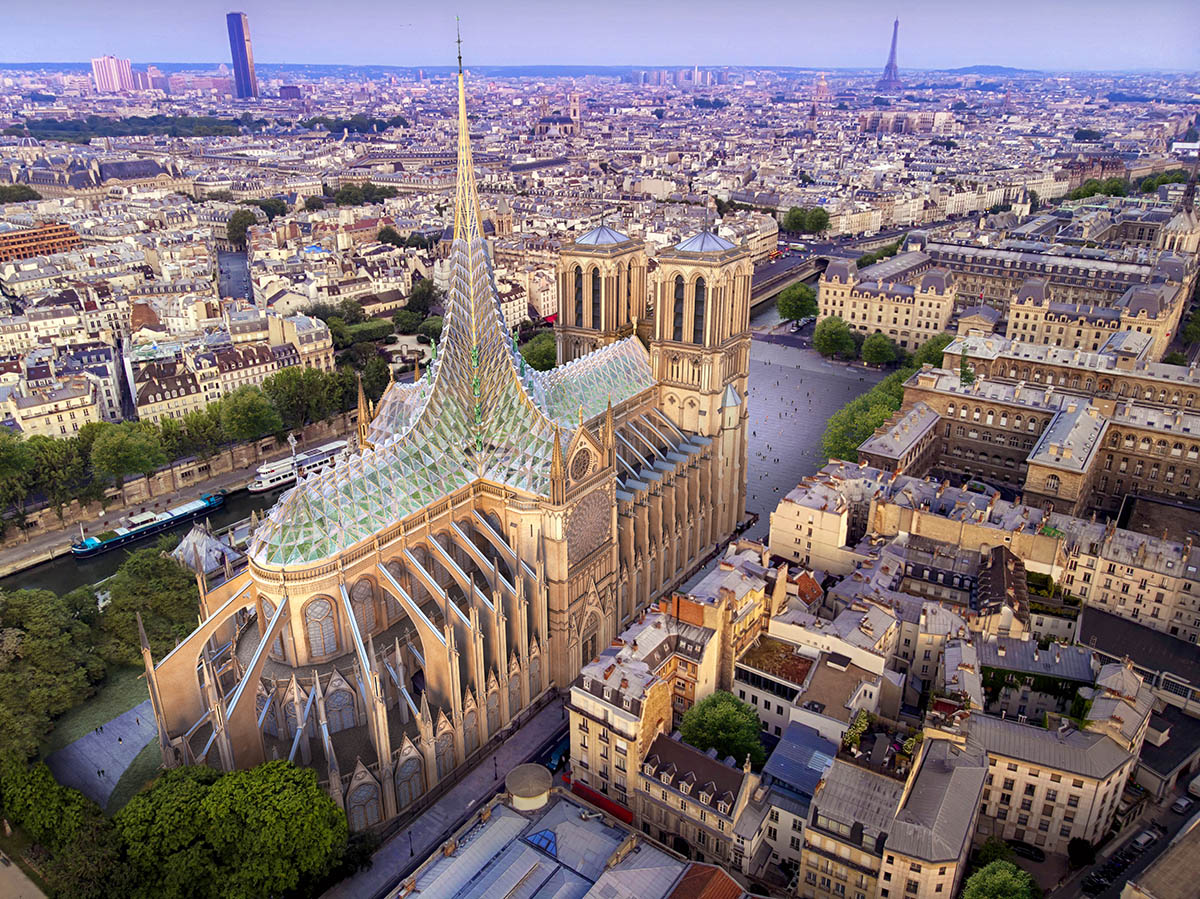Submitted by WA Contents
Vincent Callebaut proposes biosourced spire and 3D Gothic stained glass roof for Notre-Dame Cathedral
France Architecture News - May 06, 2019 - 05:10 21627 views

French ecological architect Vincent Callebaut's firm Vincent Callebaut Architectures has reenvisioned the roof and spire of the Notre-Dame Cathedral with Gothic-styled roof and biomimetic forest.
Submitting many different proposals from all over the world, architects submit their ideas to expand the cathedral in a much more innovative ways by using today's cutting-edge technologies, following the announcement of an international competition by the France government.
Callebaut's design scheme presents a transcendent concept to be a symbol of a resilient and ecological future that offers the city a set of solutions. Inspired by biomimicry, the architect tries to define a common ethic for a fairer symbiotic relationship between humans and nature.
Called Palingenesis (in Greek παλιγγενεσία, meaning "rebirth", "regeneration"), the project aims to assimilate the venerable stone nave, to blend in naturally as a vegetal graft harmonizing in one gesture - in one single curved stroke of pencil - the roof and the spire.

From the four gables, the original geometry of the 10 meter-high attic has been respected. As visitors move towards the transept cross, its triangular section and steep, 55-degrees pitched roofs gradually stretch to shape a vertical spire.
Respecting the inherent principles of descent of the structural loads of the building towards the flying buttresses and the inner fasciculated pillars, the four roofing lines and the four lines of the roof's ribs bend and join together in harmony towards the sky, producing a parametric and light geometry.
Constructed with cross laminated timber beams pre-stressed with carbon fiber slats, the new oak frame seeks to use the minimum amount of material to ensure a low-carbon footprint while offering the greatest transparency to the cathedral. Transparency, sharing and openness to our society's development: such are the ideas conveyed by this new, diaphanous forest of Notre-Dame, outlining the new face of the Church in the 21st century. A dynamic, agile and contemporary Church.

"Its pure and elegant architecture invites us to elevate our spirituality and adopt a much-needed and overly altruistic and humanistic stance towards the world around us, with a view to its better preservation," said Vincent Callebaut Architectures.
"The four great hip rafters are oriented towards the cardinal points. Between the four ridges which give the roof its sophisticated character, their curves reincorporate one above the other the monumental, wrought-copper statues of the twelve apostles, and the tetramorphs symbolizing the evangelists."
"Fortunately, these sixteen statues, work of Adolphe-Victor Geoffroy-Dechaume, had been removed four days before the fire - i.e. on April 11, 2019 - for restoration."

The rooster located and found in the rubble the day after the disaster will crown the spire again; in this position, it should remain the "spiritual lightning rod" and protector of the faithful.
The new architecture of the spire, like a shroud raised from the keystone of the transept crossing, evokes the rebirth but also the mystery of the cathedral and the resurrection of Christ. And under the shroud, life and renewal emerge. Notre-Dame dazzles the world again while amplifying her universal message of peace and her spiritual aspiration.
At its heart, the Palingenesis project features a garden devoted to contemplation and meditation. Needless to say, this garden serves aesthetic but also nourishing purposes. Indeed, it is cultivated by volunteers and charitable associations to help the most deprived and homeless Parisians.
This urban farm is arranged atop the Latin-cross plan of the roof and set in planters, which essentially redraw the layout of six-part vaults on the ground. This geometric garden "à la française" relies on a double-deck structure with light soil to grow its fruits and vegetables along the nave, from East to West, from the two towers to the apse.
In the North-South axis, the roofs of the transept hosts aquaponic basins feeding plants with natural, fish fertilizers. Moreover, these water mirrors expand the place by reflecting the rose windows on the North and South side gables.

"We advocate for an exemplary project in ecological engineering that feels true to its time and avoids a pastiche architecture that turns the city into an open-air museum. Circular economy, renewable energies, inclusive social innovation, urban agriculture, protection of biodiversity, without forgetting beauty and spiritual elevation: our reconstruction project feeds on such values to deliver a deep, conscious meaning," said Vincent Callebaut Architectures.
"From primitive Gothic in the 12th century to its restoration by Viollet-le Duc in the 19th century, through the radiant Gothic of the 13th century and the flamboyant Gothic of the 14th century, Notre-Dame cathedral undoubtedly arises from centuries of work and multi-faceted inspiration. As such, it is hardy encumbered by useless musings about the overlapping styles inherent in the building."
Recently, heritage experts warned that five-year plan is impossible for the Notre-Dame Cathedral. See other proposals for the Notre-Dame Cathedral on France Country Page.
All images courtesy of Vincent Callebaut Architectures
